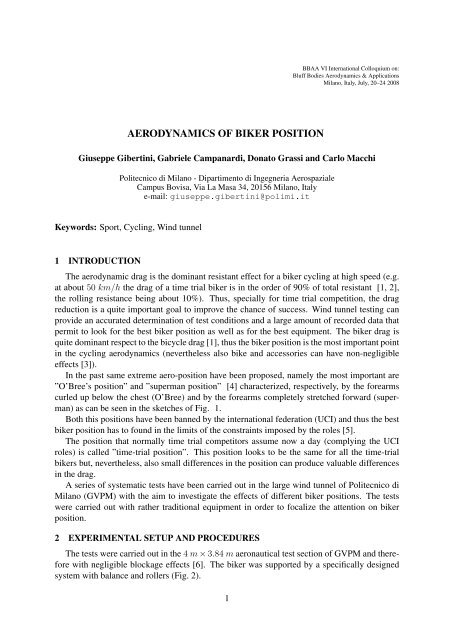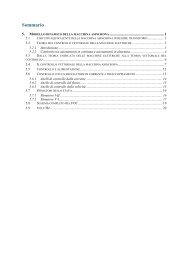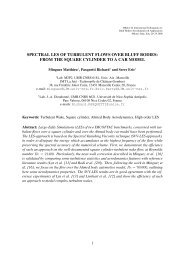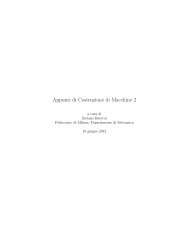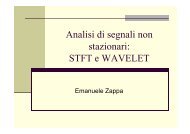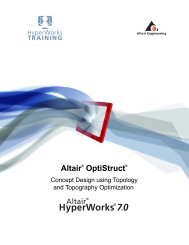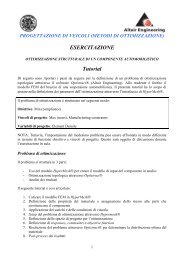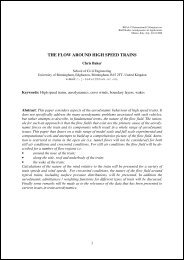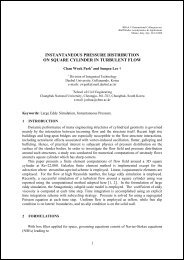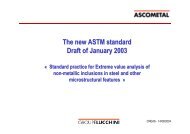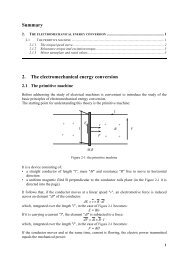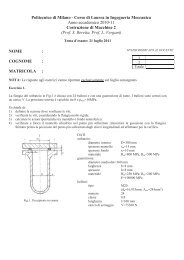aerodynamics of biker position - BBAA VI - Politecnico di Milano
aerodynamics of biker position - BBAA VI - Politecnico di Milano
aerodynamics of biker position - BBAA VI - Politecnico di Milano
- No tags were found...
You also want an ePaper? Increase the reach of your titles
YUMPU automatically turns print PDFs into web optimized ePapers that Google loves.
<strong>BBAA</strong> <strong>VI</strong> International Colloquium on:Bluff Bo<strong>di</strong>es Aerodynamics & Applications<strong>Milano</strong>, Italy, July, 20–24 2008AERODYNAMICS OF BIKER POSITIONGiuseppe Gibertini, Gabriele Campanar<strong>di</strong>, Donato Grassi and Carlo Macchi<strong>Politecnico</strong> <strong>di</strong> <strong>Milano</strong> - Dipartimento <strong>di</strong> Ingegneria AerospazialeCampus Bovisa, Via La Masa 34, 20156 <strong>Milano</strong>, Italye-mail: giuseppe.gibertini@polimi.itKeywords: Sport, Cycling, Wind tunnel1 INTRODUCTIONThe aerodynamic drag is the dominant resistant effect for a <strong>biker</strong> cycling at high speed (e.g.at about 50 km/h the drag <strong>of</strong> a time trial <strong>biker</strong> is in the order <strong>of</strong> 90% <strong>of</strong> total resistant [1, 2],the rolling resistance being about 10%). Thus, specially for time trial competition, the dragreduction is a quite important goal to improve the chance <strong>of</strong> success. Wind tunnel testing canprovide an accurated determination <strong>of</strong> test con<strong>di</strong>tions and a large amount <strong>of</strong> recorded data thatpermit to look for the best <strong>biker</strong> <strong>position</strong> as well as for the best equipment. The <strong>biker</strong> drag isquite dominant respect to the bicycle drag [1], thus the <strong>biker</strong> <strong>position</strong> is the most important pointin the cycling <strong>aerodynamics</strong> (nevertheless also bike and accessories can have non-negligibleeffects [3]).In the past same extreme aero-<strong>position</strong> have been proposed, namely the most important are”O’Bree’s <strong>position</strong>” and ”superman <strong>position</strong>” [4] characterized, respectively, by the forearmscurled up below the chest (O’Bree) and by the forearms completely stretched forward (superman)as can be seen in the sketches <strong>of</strong> Fig. 1.Both this <strong>position</strong>s have been banned by the international federation (UCI) and thus the best<strong>biker</strong> <strong>position</strong> has to found in the limits <strong>of</strong> the constraints imposed by the roles [5].The <strong>position</strong> that normally time trial competitors assume now a day (complying the UCIroles) is called ”time-trial <strong>position</strong>”. This <strong>position</strong> looks to be the same for all the time-trial<strong>biker</strong>s but, nevertheless, also small <strong>di</strong>fferences in the <strong>position</strong> can produce valuable <strong>di</strong>fferencesin the drag.A series <strong>of</strong> systematic tests have been carried out in the large wind tunnel <strong>of</strong> <strong>Politecnico</strong> <strong>di</strong><strong>Milano</strong> (GVPM) with the aim to investigate the effects <strong>of</strong> <strong>di</strong>fferent <strong>biker</strong> <strong>position</strong>s. The testswere carried out with rather tra<strong>di</strong>tional equipment in order to focalize the attention on <strong>biker</strong><strong>position</strong>.2 EXPERIMENTAL SETUP AND PROCEDURESThe tests were carried out in the 4 m × 3.84 m aeronautical test section <strong>of</strong> GVPM and thereforewith negligible blockage effects [6]. The <strong>biker</strong> was supported by a specifically designedsystem with balance and rollers (Fig. 2).1
Giuseppe Gibertini, Gabriele Campanard, Donato Grassi and Carlo Macchivalue obtained in the tra<strong>di</strong>tional <strong>position</strong> agrees very well with the result found in the literature[2] obtained with in-field measurements. The test results on time-trial <strong>position</strong>s showedthat an accuraltely adjusted time-trial <strong>position</strong> (still complying the UCI roles) can produce adrag reduction in the order <strong>of</strong> 20% (respect to the tra<strong>di</strong>tional <strong>position</strong>) that is the same order <strong>of</strong>advantage that can be obtained by the more “exotic” O’Bree’s <strong>position</strong> (not complying the UCIroles) [2].5 ACKNOWLEDGEMENTSThe authors want to thank the <strong>biker</strong> Enrico De Angeli that kindly accepted to be submittedto very exhausting wind tunnel tests (that he always performed very pr<strong>of</strong>essionally). Thanksalso to Luca Guercilena and Luca Minesso that never denied their advice. Finally, it’s a plesureto recall the collaboration <strong>of</strong> the Experimental Fluid Dynamics course students (Academic Year2006/2007) in the tests implementation.REFERENCES[1] S.P. Burns and J.P. Sullivan. Aerodynamics <strong>of</strong> The Rider - Bicycle Combination CyclingScience, 6, N.4, 8–10 and 22–23, 1995.[2] F. Grappe and R. Candau and A. Belli and J.D. Rouillon. Aerodynamic drag in field cyclingwith special reference to the Obree’s <strong>position</strong>. Ergonomics, 40, 1299–1311, 1997.[3] C.R. Kyle. Wind Tunnel Tests <strong>of</strong> Bicycle wheels & Helmets Cycling Science, 2, N.1, 27–30, 1990.[4] R.A. Lukes and S.B. Chin and S.J. Haake. The understan<strong>di</strong>ng and development <strong>of</strong> cycling<strong>aerodynamics</strong>. Sports Engineering, 8, 59–74, 2005.[5] UCI Cycling Regulations: Part 1 General Organization <strong>of</strong> Cycling as a Sport, 2007.[6] J.B. Barlow and W.H Rae and A.Pope. Low-speed wind tunnel testing. John Wiley & Sons,1999.4


